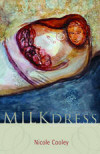Milk Dress
Milk Dress has many strengths, exhibiting great poetic control and elegance, but no aspect of the book is more interesting to me than Cooley’s successful linking of “world events” and “bodily/personal events,” her experience of pregnancy, birth, motherhood, illness, loss and birth (rebirth?) again “against” (“Write against narrative” she begins in “Homeland Security,” the opening poem) the events of 9/11, Hurricane Katrina, the daily news, the threat of global disaster. “Write against blankness,” she instructs herself, and, by implication, simultaneously instructs us: read against blankness (“white, white, white”), the empty post-terrorist sky; the empty post-pregnancy crib; the unturned (pre-and-post reading) page.
Milk Dress has many strengths, exhibiting great poetic control and elegance, but no aspect of the book is more interesting to me than Cooley’s successful linking of “world events” and “bodily/personal events,” her experience of pregnancy, birth, motherhood, illness, loss and birth (rebirth?) again “against” (“Write against narrative” she begins in “Homeland Security,” the opening poem) the events of 9/11, Hurricane Katrina, the daily news, the threat of global disaster. “Write against blankness,” she instructs herself, and, by implication, simultaneously instructs us: read against blankness (“white, white, white”), the empty post-terrorist sky; the empty post-pregnancy crib; the unturned (pre-and-post reading) page.
Cooley takes us from morning sickness experienced carrying a first child (“My body is its own shipwreck”); through the baby’s problematic birth, illness, and death (“Body that now in the world she can’t keep safe”); and finally into a newly renewed sense of life with the daughters who (later) thrive (“Now my two girls running on the lawn beyond // the museum, behind the black gate, my girls / who cannot be bodiless.”)
Write/read against narrative: in Milk Dress every body, every experience, every event is a text—or relates to a text—of one kind or another. Pregnancy is a Cassatt print in Special Collections (“Pregnant at the Archive”). Life with a newborn, the poet imagines, is mother and child “like the pages of a book, unwritten, open forever.” The experience of emergency hospitalization is a photograph (“Photograph #1, The Lying in Hospital”). The events of 9/11 are the subject of a student writing class (“Pedagogy, 2001”). Coping with disaster requires an “instruction manual,” and is the source for a small thesaurus: “mischance, misfortune, misadventure, mishap.” Taking care of a sick child sends an anxious mother to a time-honored reference book (“Dr. Spock’s Common Sense Book of Baby Care and Child Care”). After surviving great trauma and loss, “skin is a map” (“Ghazal of Nines”) and the marriage bed, where new life (and new poems) will be conceived, is a “canvas.”
Milk Dress is the rare “project” book that manages to be as interesting to a reader as it likely was, in process, to its maker. It strives carefully and deliberately to bring together the whole of its narrative, while pausing for just the right click of the shutter, just the right brush stroke at each image (I’m thinking here of Cooley’s documentary poems, photographs, references to paintings). This is narrative in the service of poetic elegance and economy; life as disaster, and disaster as text. Life, in fact, as death; and as new life, new text. The page, finally, turned.





